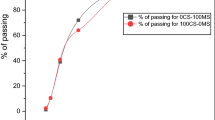Abstract
The corrosion rate is an essential parameter for predicting the service life of reinforced structural parts. The Tafel plots derived from the linear polarization resistance techniques, accelerated corrosion test, and gravimetric weight loss method were used to evaluate the corrosion performance of the reinforced steel of the proposed geopolymer concrete (GPC). The influence of molarity on compressive strength and corrosion test (through the chloride ion penetration) of the optimum mix proportions in the binary and ternary blends has been investigated. In this research, copper slag is fully replaced with fine aggregate, and the binder composition of GPC was prepared from class F fly ash, GGBS, and rock phosphate powder (RPP) for ternary mix proportions which was adopted, and GGBS and RPP for the production of binary blends in the 12 and 14 molar concentration were investigated for the constant silica/hydroxide ratio of 2 and alkaline/binder ratio of 0.35 for the cylindrical specimens with steel bar embedded at 20-mm coverings. When compared to standard concrete, the GPC lollipop sample significantly reduced the corrosion rate even in the presence of a 5% chloride environment. This is because phosphate’s natural corrosion-inhibiting property has decreased the deleterious impact of the copper slag and improved the performance of the structure.











Similar content being viewed by others
References
Anurag M, Deepika C, Namrata J, Manish K, Nidhi S, Durga D (2008) Effect of concentration of alkali liquid and curing time on strength and water absorption of geopolymer concrete. Eng Appl Sci 3:14–18
ASTM G102 Calculation of corrosion rates and related information from electrochemical measurements
ASTM G31 Immersion corrosion test of metals
Chindaprasirt P, Chalee W, Jaturapitakkul C, Rattanasak U (2009) Comparative study on the characteristics of fly ash and bottom ash geopolymers. Waste Manage 29:539–543
Davidovits J (1994) Properties of geopolymer cements. In: Krivenko PV (ed) Alkaline cements and concretes, vol 1. Vipol Stock. Kiev, Ukraine, pp 131–149
Glukhovsky VD (1965) Soil silicates. Their properties, technology and manufacturing and fields of application. Doct Tech Sc. Degree Thesis. Civil Engineering Institute. Kiev (Ukraine)
Harilal M, Kamde DK, Uthaman S, George RP, Pillai RG, Philip J, Albert SK (2021) The chloride-induced corrosion of a fly ash concrete with nanoparticles and corrosion inhibitor. Constr Build Mater 274:122097
Huajun Z, Zuhua Z, Fenggan D, Yalong C (2013) The effects of phase changes on the bonding property of geopolymer to hydrated cement. Constr Build Mater 48:124–130
Krivenko PV (1997) Alkaline cements: terminology, classification, aspects of durability. In: Proceedings of 10th International Congress on the Chemistry of Cement. Goteborg (Sweden), pp 4iv046–4iv050
Lopez-Calvo HZ, Montes-Garcia P, Bremner TW, Thomas MDA, Jiménez-Quero VG (2012) Compressive strength of HPC containing CNI and fly ash after long-term exposure to a marine environment. Cem Concr Compos 34:110–118
Miranda JM, Fernandez-Jimenez A, Gonzalez JA (2005) Corrosion resistance in activated fly ash mortars. Cem Concr Res 35:1210–1217
Palomo A, Grutzeck MW, Blanco MT (1999) Alkali-activated fly ashes. A cement for the future. Cem Concr Res 29:1323–1329
Rattanasak U, Chindaprasirt P (2009) Influence of Na(OH) solution on the synthesis of fly ash geopolymer. Miner Eng 22:1073–1078
Reddy DV, Baptiste J (2013) Durability of Fly ash based geopolymer structural concrete in the marine environment. J Mater Civ Eng ASCE 25(6):781–787
Ryu GS, Lee YB, Koh KT, Chung YS (2013) The mechanical properties of fly ash-based geopolymer concrete with alkaline activators. Constr Build Mater 47:409–18
Tailing B, Brandster J (1989) Present state and future of alkali-activated slag concretes. In: 3rd International Conference of Fly Ash, Silica Fume, Slag and Natural Pozzolans in Concrete. SP 114–74, Tondheim (Norway), pp 1519–1546
Thomas MDA, Matthews JD (2004) Performance of pfa concrete in a marine environment-10-year result. Cem Concr Res 26:5–20
Wang SD, Scrivener KL (1995) Hydration products of alkali activated slag cement. Cem Concr Res 25:561–571
Author information
Authors and Affiliations
Corresponding author
Rights and permissions
Springer Nature or its licensor (e.g. a society or other partner) holds exclusive rights to this article under a publishing agreement with the author(s) or other rightsholder(s); author self-archiving of the accepted manuscript version of this article is solely governed by the terms of such publishing agreement and applicable law.
About this article
Cite this article
Dharmar, B., Muthuramalingam, P. & Kumar, P. Study on the Influence of Corrosion and Cracking in the Phosphate-Based Geopolymer Concrete Incorporated with Copper Slag. Iran J Sci Technol Trans Civ Eng 47, 3333–3343 (2023). https://doi.org/10.1007/s40996-023-01250-3
Received:
Accepted:
Published:
Issue Date:
DOI: https://doi.org/10.1007/s40996-023-01250-3




